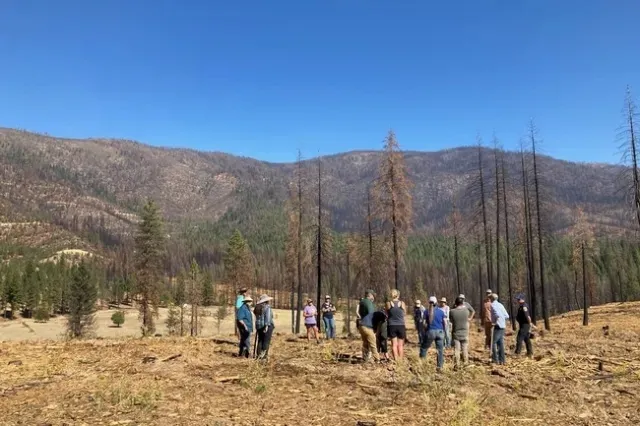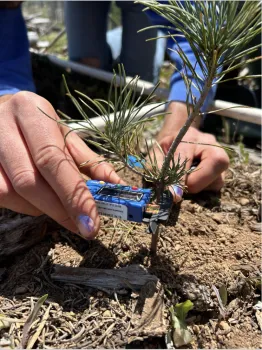For Sutter Rogers, community and forest stewardship has been the family business since 1965. That’s when her grandparents bought 200-acres of Plumas County forestland, a site that would become Coppercreek Camp. “They built the cabins and the lodge on their own. It was their dream to have a children’s summer camp,” Rogers says. The site was managed by Rogers and her husband when the 2021 Dixie fire arrived and burned nearly 90% of the campground. Over the last few years, the two have implemented post-fire treatments on Coppercreek Camp with the assistance of the Feather River Resource Conservation District (RCD), making the space into one representative of community resilience and healing.

Immediate assistance post-wildfire is critical for forest landowners like Rogers who aim to reforest their landscape. As a lead agency for a pilot Emergency Forest Restoration Team (EFRT) program, the Feather River RCD was able to quickly masticate, treat brush, remove hazard trees, and replant on Rogers’s forestland at no cost to her family. “Having the RCD come along made the process simple and understandable,” she says. “When you’re a landowner post-fire, you need someone like that to advocate for you and explain this whole new world of managing forestland.”
Navigating the space of forestland management post-fire can be incredibly overwhelming, Rogers shares. This is when support and solidarity from neighbors and local organizations is crucial. She notes: “There are so many people willing to make their property more fire safe, but sometimes it does take signing your neighbor up for a program or completing most of their paperwork and just having them sign the dotted line.”

Now, Rogers and her family enjoy hiking the property and seeing how the forest is recovering. The pine seedlings are “doing really well”, and the oaks are coming back and “thriving”. Rogers describes a specific hillside where she and her family can look out and see the various treatments, which is something she also enjoys sharing with others. “We love having the community come out here, so that other landowners can see what we’ve done,” she says. Coppercreek Camp will also host UC ANR Post-Fire Forest Resilience workshop participants for a May in-person field trip, where more forest landowners can get a first-person look at those post-fire treatments.
“I can’t say enough about the importance of community,” Rogers shares. “Even if you didn’t lose a home or a property during a fire, you’re still a part of the recovery process. It’s ok to feel loss and do what you can to contribute.”
Registration is open for the Plumas cohort of the UC ANR Post-Fire Forest Resilience Workshop Series. The workshop will run from April 30-May 28, with an in-person field trip on Saturday, May 31. Private forest landowners and interested community members in Plumas and surrounding counties are encouraged to join, and can register here: https://surveys.ucanr.edu/survey.cfm?surveynumber=37755

